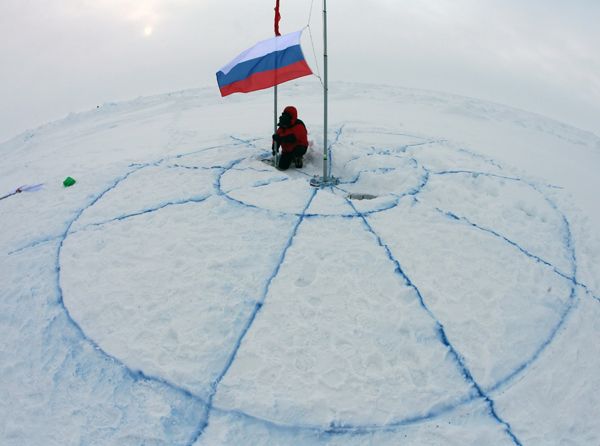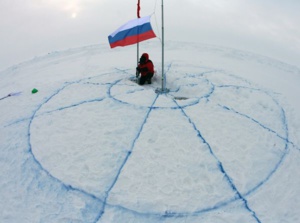- The federal budget allocated a subsidy of 205 mln rubles (about $4 mln) for the resumption of the national research expeditions in the Arctic. This will contribute to the stabilization and development of the activity of Russia in the world's oceans, including in connection with the growing needs of wildlife in the Arctic and its protection of the environment - it is said in reference to the document.
- Drifting station" North Pole "- the most important factor in ensuring Russia's presence in high-latitude regions of the Arctic, fixing Russia's priority in conducting comprehensive research in the Arctic region, - as stated in the document.
The program of these stations was terminated in 2013 after the evacuation of "North Pole-40" because of abnormal natural processes in the Arctic zone. In 2015, the Russian station will operate not in the annual but seasonal mode. The station was opened on April 19. It will work close to the geographic North Pole ice camp near the Russian Geographical Society. Its staff will consist of 16 people.
How the Arctic was developed
Arctic is the northern polar region of the Earth, including Arctic Ocean and its seas: Greenland, Barents, Kara, Laptev, East Siberian, Chukchi and Beaufort, as well as Baffin Bay, Foxe Basin, numerous bays and straits of Canadian arctic archipelago, northern Pacific and Atlantic Oceans; Canadian arctic archipelago, Greeland, Spitzbergen and others.
September 13, 2008, the Canadian-American expedition was launched, which was attended by the Arctic Coast Guard icebreaker Healy and US heaviest Coast Guard icebreaker Louis S. St. Canada Laurent.
The aim of the mission was the collection of information that will help determine the extent of the continental shelf of the United States in the Arctic Ocean.
August 7, 2009 the second US-Canadian Arctic expedition kicked off. Scientists of the two countries collected data on the seabed and the continental shelf from the US Coast Guard icebreaker Healy and Canadian Coast Guard ship Louis S. St-Laurent, where, as expected, there are rich deposits of oil and gas. The expedition worked in the areas of the north Alaska to the Mendeleev Ridge and east of the Canadian Arctic Archipelago. Scientists made photo and video, as well as collected materials on the state of the sea and the continental shelf.
More and more states are showing the interest to participate in the active development of the Arctic zone are. This is opening up new possibilities for establishing a regular shipping in the Arctic Ocean due to global climate change, as well as greater access to mineral resources in this vast region.
- Drifting station" North Pole "- the most important factor in ensuring Russia's presence in high-latitude regions of the Arctic, fixing Russia's priority in conducting comprehensive research in the Arctic region, - as stated in the document.
The program of these stations was terminated in 2013 after the evacuation of "North Pole-40" because of abnormal natural processes in the Arctic zone. In 2015, the Russian station will operate not in the annual but seasonal mode. The station was opened on April 19. It will work close to the geographic North Pole ice camp near the Russian Geographical Society. Its staff will consist of 16 people.
How the Arctic was developed
Arctic is the northern polar region of the Earth, including Arctic Ocean and its seas: Greenland, Barents, Kara, Laptev, East Siberian, Chukchi and Beaufort, as well as Baffin Bay, Foxe Basin, numerous bays and straits of Canadian arctic archipelago, northern Pacific and Atlantic Oceans; Canadian arctic archipelago, Greeland, Spitzbergen and others.
September 13, 2008, the Canadian-American expedition was launched, which was attended by the Arctic Coast Guard icebreaker Healy and US heaviest Coast Guard icebreaker Louis S. St. Canada Laurent.
The aim of the mission was the collection of information that will help determine the extent of the continental shelf of the United States in the Arctic Ocean.
August 7, 2009 the second US-Canadian Arctic expedition kicked off. Scientists of the two countries collected data on the seabed and the continental shelf from the US Coast Guard icebreaker Healy and Canadian Coast Guard ship Louis S. St-Laurent, where, as expected, there are rich deposits of oil and gas. The expedition worked in the areas of the north Alaska to the Mendeleev Ridge and east of the Canadian Arctic Archipelago. Scientists made photo and video, as well as collected materials on the state of the sea and the continental shelf.
More and more states are showing the interest to participate in the active development of the Arctic zone are. This is opening up new possibilities for establishing a regular shipping in the Arctic Ocean due to global climate change, as well as greater access to mineral resources in this vast region.






